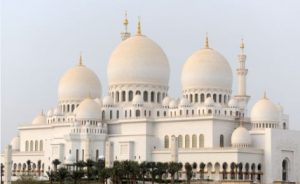Arab Countries In Transition: Where are they Heading?
By Masood Ahmed
Director of the IMF’s Middle East and Central Asia Department
“You can tell whether a man is clever by his answers. You can tell whether a man is wise by his questions.”
— Egyptian Nobel Prize–winning author Naguib Mahfouz
 The change that swept through the Arab world in spring 2011 unleashed a new optimism in the region, but many are now asking where the transition is headed.
The change that swept through the Arab world in spring 2011 unleashed a new optimism in the region, but many are now asking where the transition is headed.
The transformation in the Middle East presents a historic opportunity for the Arab countries in transition as they rethink not only their political but also their economic systems. Some of these countries have witnessed regime change (Egypt, Libya, Tunisia, Yemen) while others are undertaking political reforms from within (Jordan, Morocco). All of them can benefit from broad reforms to create more dynamic and inclusive economies that provide economic opportunity to all segments of society.
Toward a Guiding Vision
The year 2013 will be another difficult one for the Arab countries in transition. Only moderate economic recovery is in the cards—not enough to generate the jobs needed to meaningfully tackle the region’s substantial unemployment. And the tragic conflict in Syria is leading to a serious humanitarian crisis that is having spillover effects on neighboring countries too, especially Jordan and Lebanon.
Important as it is now to focus on maintaining economic stability, it is vital not to lose sight of the more fundamental medium-term challenge of modernizing and diversifying the region’s economies, creating more jobs, and providing fair and equitable opportunities for all. Restless populations’ growing impatience for quick results—in the form of new jobs and better incomes and social conditions—is an incentive for policymakers to proactively introduce changes to the existing economic systems (see “Freedom and Bread Go Together,” in this issue of F&D).
A comprehensive reform program needs to provide clear goals for the economic transition. Unlike the transformation of Eastern Europe more than 20 years ago, during which many countries turned toward the European Union (EU) and its economic model, today’s Arab countries in transition lack a clear role model for their final economic destination. But like oarsmen racing a rowboat, only if people act jointly, driven by a common goal, can they excel.
Comprehensive economic reforms are needed to change these economies from following a “rent-seeking” model—in which firms aim to prosper from special government privileges or monopoly rights—to one whose guiding principle is the creation of economic value and jobs. But while such transformations produce winners, they also create losers, many of them politically well connected. Such vested interests will fight reform. But during the political upheaval that accompanies the creation of a new order the influence of such interests could be reduced—opening a window to reform.
National policymakers are clearly responsible for defining their reform agendas, but the international community can help by offering financing, policy advice, and better market access for the region’s exports. The international community has already provided substantial financial assistance. Apart from sizable contributions from bilateral donors, especially the countries of the Gulf Cooperation Council, international financial institutions have committed $18.5 billion since the beginning of the transition, not counting the IMF’s commitment of more than $8 billion to support home grown economic programs in Jordan, Morocco, and Yemen. The IMF is also engaged in discussions on financial support for Egypt and Tunisia. More financing is clearly needed, and beyond financing, better trade access and technical policy advice will also be crucial. The economic challenges in the Arab countries in transition extend well beyond the IMF’s expertise. Development agencies such as the World Bank and other international and regional financial institutions, as well as bilateral partners, are also contributing and must continue to do so in the period ahead.
Structural Challenges
 The Arab countries in transition have long suffered from a lack of dynamism, with high unemployment and—despite reform efforts—an inability to generate per capita growth on par with other emerging market and developing economies . The region’s labor force participation is low, and the responsiveness of employment to growth has been among the most sluggish in the world.
The Arab countries in transition have long suffered from a lack of dynamism, with high unemployment and—despite reform efforts—an inability to generate per capita growth on par with other emerging market and developing economies . The region’s labor force participation is low, and the responsiveness of employment to growth has been among the most sluggish in the world.
While many of these countries had moved over time to private sector–led systems, government jobs remain much more important than in other regions. The economic vitality that helped lead the transformation in emerging market and developing economies in other regions has been absent in many Arab countries.
To unlock the region’s vast potential, many factors come into play, and the recipe for reform will naturally vary across countries. But there are some common priorities (see IMF, 2012).
Greater trade integration, both within the region and in the world economy, will be essential not only to boost growth but also as a catalyst for other important reforms. Business regulation and governance reforms are needed to ensure simple, transparent, and even handed treatment for companies, and ultimately greater transparency and accountability of public institutions. Labor market and education reforms will ensure adequate skill building and protection of workers. Improving access to finance will help catalyze entrepreneurship and private investment. And public finance reform will help free up resources for high-priority expenditures and reduce vulnerability, which will also spur growth.
Boosting Trade
In recent decades, trade has not been a significant engine of growth for Arab countries in transition. The region’s exports are both proportionally smaller than in other economies and mainly to Europe. This has prevented the region from benefiting from the high growth of many emerging markets, particularly in Asia. And progress toward exporting more higher-value-added products remains limited.
Deeper trade integration could significantly boost the region’s economies, creating growth and jobs and helping maintain the momentum for broader reform. Such integration into the global economy would also help provide discipline and incentives to enact other reforms aimed at strengthening competitiveness.
“In recent decades, trade has not been a significant engine of growth for Arab countries in transition.”
For the Arab countries in transition, trade integration will first and foremost require better access to advanced economy markets. For instance, high tariffs, quota restrictions, and farm subsidies remain a significant impediment to agricultural exports to the EU, and current agreements with the EU do not provide for liberalization in trade in services.
To fully reap the benefits of integrating into global trade, the Arab countries in transition should also further liberalize their own tariffs and nontariff barriers and diversify trade toward fast-growing emerging markets. Increased regional integration, by addressing nontariff barriers and harmonizing policies, would also help the Arab countries in transition integrate into the global supply chain.
Business Made Simpler
These Arab countries face a legacy of complex and burdensome business regulations. Egypt, for example, has 36,000 often overlapping regulations that affect the private sector. As a result, it is often a lengthy, expensive, and complicated proposition to start and run a business.
Most countries in the region fare poorly on global governance rankings, and increasingly so over the past decade. Corruption is a major problem: more than half the firms in the Middle East and North Africa region report that they have been asked for bribes—a much higher share than in any other region in the world (World Bank Enterprise Surveys).
Although many countries have already taken action, it will take continued and intensified efforts to improve business regulation and governance. Lasting success calls for a system of checks and balances to insulate key national and regional institutions from excessive government discretion and non-transparent intervention. The experience of east Asia, for example, shows that countries that are effective in creating accountable, rules-based institutions generate significantly more economic growth than those whose institutions remain subject to arbitrary intervention by political leaders and public officials (World Bank, 2009).
Although countries differ in their reform needs, strategies to reform business regulation should focus on removing the barriers to starting or closing a business. Entry requirements—such as sector-ministry approval, which gives officials substantial discretion over which investors to favor or exclude—should be reviewed and based on clear and transparent rules. Similarly, high minimum capital requirements and restrictions on foreign ownership should be relaxed, unless they reflect a particular regulatory concern. Reform efforts should also focus on removing exit difficulties and introduce modern bankruptcy codes that decriminalize business failure.
Jobs and School
Labor markets in the Arab countries in transition face substantial problems. High unemployment is compounded by significant demographic pressure as more of the young population enters the labor market. Youth unemployment is high, ranging from 18 percent to 30 percent in Egypt, Jordan, Morocco, and Tunisia, and women face particular problems in securing employment.
Although the roots of the problem vary across countries, there are some common factors. Labor regulations discourage firms from hiring and divert job seekers into the informal sector, where workers do not enjoy the same level of protection as in the formal economy. The (implicit and explicit) employment guarantees in government hiring—and mismatched salary expectations resulting from comparatively generous civil service compensation—have led to market segmentation and excess demand for public sector jobs. The education system’s strong focus on formal qualifications for entry into the civil service means that labor market entrants often do not have the right mix of skills for today’s job market.
Solutions to these employment problems will vary among countries, but should generally address five areas: reviewing labor market regulation to reduce disincentives for hiring while maintaining adequate worker protection; revisiting public sector hiring practices and compensation policies to reduce the public sector’s labor market dominance and bias; reforming the education system, aligning it better with the needs of private employers; pursuing active labor market policies to make quicker inroads into lowering unemployment; and emphasizing policies that promote youth and female employment.
Where’s the Money?
Access to finance is a major constraint in the Arab countries in transition. Private credit disproportionately benefits large, established companies, and, in some cases, private sector credit has been crowded out by the financing of government budget deficits. Only 10 percent of firms finance investment in the MENA region through banks—by far the lowest share among the world’s regions—and 36 percent of firms in the region identify access to finance as a major constraint, surpassed only in sub-Saharan Africa (World Bank Enterprise Surveys). Smaller firms in particular, deprived of bank credit, must rely on whatever limited alternatives they can find to carry out their investment plans.
The cost of lost opportunities from limited access to finance is large. Empirical estimates show that raising access to finance in the MENA region to the world average could boost per capita GDP growth by 0.3 to 0.9 percentage point.
Expanding access to finance is thus a priority for policymakers seeking higher growth and employment. Strategies for improving access to finance will differ among the Arab countries in transition given their different starting points, but must center on developing or strengthening alternatives to bank financing, improving the financial infrastructure, and strengthening competition in the financial sector.
Taxing Times
Since 2011, government expenditure in the Arab countries in transition has been driven by the wage bill and subsidies, both of which were raised substantially in response to social pressures and higher international prices for imports. This spending has come in part at the expense of capital expenditures, which does not augur well for these countries’ medium-term growth potential. Higher government expenditures have also increased deficits and debt, both of which make countries vulnerable.
IMF estimates indicate that untargeted subsidies now cost the MENA region’s budgets almost 8 percent of GDP. Generalized subsidies are an inefficient means of social protection: only about 20 to 35 percent of spending on subsidies reaches the lowest 40 percent of the income distribution. By contrast, in well-designed means-tested cash transfer systems, typically 50 to 75 percent of spending reaches the bottom 40 percent. If such transfer systems prove hard to implement, better targeting of price subsidies is the next best approach.
“IMF estimates indicate that untargeted subsidies now cost the MENA region’s budgets almost 8 percent of GDP.”
Reforms on the revenue side will differ according to countries’ starting positions and preferences. Several countries, including Egypt, Jordan, and Yemen, have the capacity to raise additional revenue from direct taxes such as those on income, profit, and capital gains, which are now below the emerging market and developing economy average. Many countries could increase their income from a value-added tax by exempting only necessities and improving compliance. And in some cases—Egypt, for example—standard rates could be raised closer to international averages. Regardless of the choice of instrument, the objective should be a broad-based tax system that generates the necessary fiscal resources fairly and without discouraging economic activity.
Protecting the Poor
Reforms on both the expenditure and revenue side will raise money that can be spent on priorities such as infrastructure investment and health and education, which will increase growth and make it more inclusive. Some of the fiscal savings should also translate into lower fiscal deficits, which would reduce high debt—a key macroeconomic vulnerability in the region—and spur growth.
While generalized price subsidies are prevalent in the region, targeted safety nets to protect the poor and vulnerable are much less developed. Now that budgetary pressures make it all the more urgent to reform generalized subsidies, it has become equally urgent to develop better and more robust safety nets that target the needy. In some instances this will require a period of preparatory technical work, but in other areas immediate improvements can be had by leveraging existing nascent programs.
Getting the Politics Right
No doubt, implementing a comprehensive economic reform agenda will be tough, and getting the political economy right will be critical. More than ever, policymakers’ success will depend on listening to all stakeholders’ views when formulating policy agendas—including those whose voices were not heard under previous regimes.
An element of success is knowing who stands to lose as a result of reform—whether in certain regions or economic sectors or along demographic or income groups. Such knowledge can help predict opposition to proposed plans. In a second-best world, it may be necessary to move ahead with reforms that garner sufficient support and postpone others: some progress is better than none at all.
Reform plans need to be anchored in clear and measurable performance goals. Otherwise, governments risk talking about reform without implementing it.
Effective communication is key to successful change and—particularly in the era of electronic communication and social networking—needs to be an integral part of the planning process. People must understand the reasoning behind difficult decisions if they are to support tough changes. For example, when reforming subsidies, policymakers should explain how expensive and inefficient existing subsidies are and the costs they impose on other parts of the budget. And in any reform involving revenue increases or expenditure cuts, it is important to demonstrate that the proceeds are being used to good effect.
Give Change a Chance
Each country’s policymakers must articulate an agenda for economic transformation, drawing on the perspectives of various national stakeholders, the lessons of international experience, and the expertise of international agencies. The specifics will vary, but there are key common elements that respond to shared concerns. All must embark on this process with urgency, to build a shared national vision of how the economic framework will evolve and reassure hesitant investors on the future rules of engagement, thus accelerating the delivery of results that will sustain popular support for economic and social progress.
You may have an interest in also reading…
Boutiques Bet Big on 2025: Talent Wars and the Push for Revenue
The investment banking sector is gearing up for what could be a transformative year in 2025. Following a year of
IFC – International Finance Corporation: Eliminating Poverty, One Loan at a Time
The famed Peruvian economist Hernando de Soto has said it all along: The world’s destitute are oftentimes somewhat less poor
Driving Digital Transformation: Nepal SBI Bank Leads Nepal’s Banking Revolution
With a pioneering spirit and deep-rooted Indo-Nepalese collaboration, Nepal SBI Bank Ltd. is redefining the banking landscape through cutting-edge digital



















































































